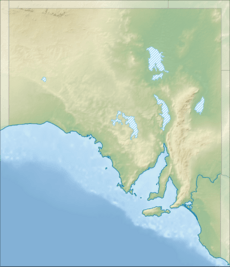Mary Seymour Conservation Park facts for kids
Quick facts for kids Mary Seymour Conservation ParkSouth Australia |
|
|---|---|
|
IUCN Category III (Natural Monument)
|
|
| Nearest town or city | Naracoorte |
| Established | 18 September 1980 |
| Area | 3.4 km2 (1.3 sq mi) |
| Visitation | ‘low’ (in 1992) |
| Managing authorities | Department for Environment and Water |
| See also | Protected areas of South Australia |
Mary Seymour Conservation Park is a special protected area in South Australia. It's a place where nature is kept safe. You can find it in the south-east part of the state. It's about 25 kilometers (about 15 miles) southwest of a town called Naracoorte.
Contents
Mary Seymour Conservation Park
This park was officially created on 18 September 1980. It was set up under a law called the National Parks and Wildlife Act 1972. This law helps protect important natural places. As of July 2016, the park covers an area of 3.4 square kilometers.
Where is the Park?
The park is located in an area called Bool Lagoon. It is bordered by the Coles-Killanoola Road on its west side. The Bool Lagoon West Road is on its north side. There are also undeveloped roads on its east and south borders.
A drain called the 'Killanoola Drain' runs through the eastern part of the park. This drain is part of a bigger system built to manage water in the area. It carries water to another drain that eventually reaches the sea at Beachport. The drain has changed how water naturally flows in the park's wetlands.
In 1992, the park also had some interesting historical spots. There was a former sand quarry and two stone quarries in the southwest. There were also old animal yards on the eastern side. These yards are important reminders of how the land was used in the past. The park has a network of tracks leading to its edges and into its center.
What's the Landscape Like?
In 1992, the park was described as having two main types of land. The western part of the park has a limestone ridge. Limestone is a type of rock. The rest of the park is a complex wetland system. Wetlands are areas where water covers the soil, or is present near the surface, for all or parts of the year. This wetland area also has limestone sticking out of the ground.
Plants and Trees
The park is home to different types of plants and trees. These plants grow in specific areas of the park:
- The western part, with its limestone ridge, has a "low open forest." This forest includes trees like brown stringybark and pink gum. There are also a few low shrubs.
- In the wetland system, you can find a mid-dense shrub area. This area has mallee honey-myrtle (Melaleuca neglecta). It also has cutting grass and small darwinia.
- Another part of the wetland has a low shrub area. Here you'll see prickly tea-tree and mallee honey-myrtle. Other plants like clustered sword-sedge and running marsh-flower also grow here.
- There are also isolated trees in the park. These include South Australian blue gum, pink gum, and river red gum. The ground beneath these trees has plants like clustered sword-sedge and annual grasses.
Visiting the Park
In 1992, not many people visited Mary Seymour Conservation Park. Most visitors were from nearby towns like Naracoorte. They came to study nature. The old sand quarry was a popular spot for picnics. Camping was an occasional activity, but there were no special camping sites or facilities.
The park is recognized internationally as an IUCN Category III protected area. This means it's considered a "Natural Monument or Feature." It's a place protected for its unique natural features.


